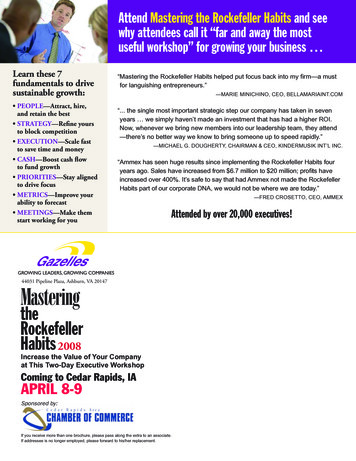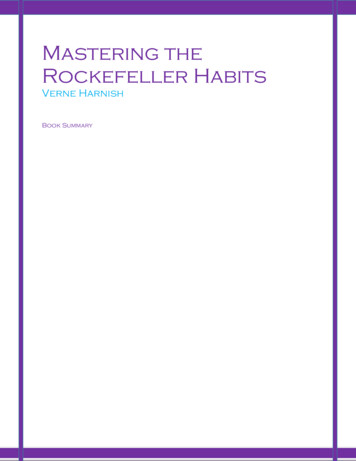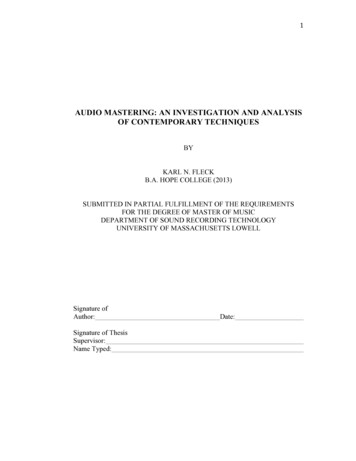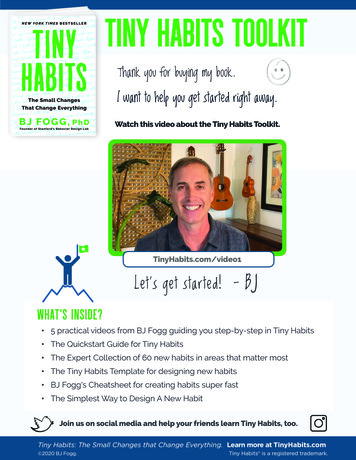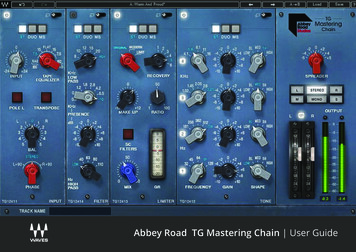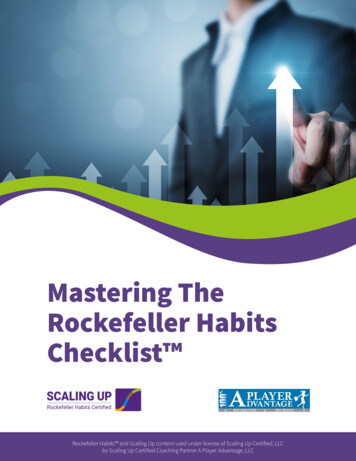
Transcription
Mastering TheRockefeller HabitsChecklist Rockefeller Habits and Scaling Up content used under license of Scaling Up Certified, LLCby Scaling Up Certified Coaching Partner A Player Advantage, LLC
Table of ContentsPage01ROCKEFELLER HABIT #1 – HEALTHY TEAM0502ROCKEFELLER HABIT #2 – TEAM ALIGNED ON THE #1 PRIORITY0603ROCKEFELLER HABIT #3 – MEETING RHYTHMS0804ROCKEFELLER HABIT #4 – THE FACE AND PACE OF THE COMPANY:FUNCTIONAL AND PROCESS ACCOUNTABILITY1105ROCKEFELLER HABIT #5 – GATHER EMPLOYEE INPUT1406ROCKEFELLER HABIT #6 – GATHER CUSTOMER INPUT1607ROCKEFELLER HABIT #7 – CORE VALUES AND PURPOSE ARE“ALIVE” IN THE ORGANIZATION2008ROCKEFELLER HABIT #8 – YOUR ENTIRE TEAM CAN ARTICULATEYOUR STRATEGY2409ROCKEFELLER HABIT #9 – KPIS FOR EVERYONE2710ROCKEFELLER HABIT #10 – SCOREBOARDS EVERYWHERE29
In 2002, business growth expert Verne Harnish published his seminal best-selling business bookMastering the Rockefeller Habits: What You Must Do to Increase the Value of Your Growing Firm.It detailed a set of ten 100-year old management principles used by the great John D. Rockefeller,the founder of Standard Oil and widely considered the wealthiest person in modern history. TheRockefeller Habits were further expanded on in Harnish’s subsequent book Scaling Up – Mastering theRockefeller Habits 2.0 that was also a best seller.The Rockefeller Habits Checklist stands as one of the best frameworks to execute your company’sstrategy. It ties into the Scaling Up Growth Tools framework. This simple 10 item checklist thatencompasses 40 vital leadership and management habits has already helped over 40,000 companiesscale up to over 10 million, 100 million, a few a billion, and beyond! The checklist has reduced thetime requirements and inherent stresses that running a business often dictates, and at the same time, itincreases the fun, fortune, and cash flow of the company. That’s the goal, right?Mastering The Rockefeller Habits Checklist 3A Player Advantage, LLC www.aplayeradvantage.com
How to Implement the Rockefeller Habits:The best way to implement the Rockefeller Habits is to introduce only one or two each quarter. Yourchoice of habits to focus on initially is based on what you and your executive team believe will giveyour company the most benefit. As a result, over a 24 – 36 month period you will make considerableprogress on all ten habits. Once you have implemented each habit, in the spirit of lean management,the best practice is to go back to each one for further process improvement. It is our belief at Scaling Upthat a firm routine with rhythm is the best methodology, or tool, to effectively implement the habits. AsHarnish says, “Routine sets you free,” and this has proven to be true time and time again.Please note that as a certified Scaling Up coaching partner, some sections of this guide are directlysourced from Scaling Up and used with permission of Scaling Up Certified, LLC.What Are the10 Rockefeller Habits?01 The executive team is healthy and aligned.02 Everyone is aligned with the #1 thing that needs to be accomplished this quarter to move thecompany forward.03 Communication rhythm is established, and information moves through the organizationquickly.04 Every facet of the organization has a person assigned with accountability for ensuring goalsare met.05 Ongoing employee input is collected to identify obstacles and opportunities.06 Reporting and analysis of customer feedback data is as frequent and accurate as financialdata.07 Core Values and Purpose are “alive” in the organization.08 Employees can articulate the key components of the company’s strategy accurately.09 All employees can answer quantitatively whether they had a good day or week.10 The company’s plans and performance are visible to everyone.Mastering The Rockefeller Habits Checklist 4A Player Advantage, LLC www.aplayeradvantage.com
The Rockefeller Habits Checklist Rockefeller Habit #1 – Healthy TeamThe executive team ishealthy and aligned1.11.21.31.4Team members understand each other’s differences, priorities, and styles.The team meets frequently (weekly is best) for strategic thinking and renewal.The team participates in ongoing executive education (monthly recommended).The team is having fun together and is able to engage in constructive debates, and allmembers feel comfortable participating.This #1 Rockefeller Habit is the most important and must be the first one to be implemented. Unlessyou have a healthy and aligned executive team that knows how to debate critical issues and “fight fair”without feuding and creating unhealthy resentments and fiefdoms, you will not be able to effectivelyimplement anything else in your business.The best practice here is to use Patrick Lencioni’s The Five Dysfunctions of a Team framework. Byfollowing the tenets of this framework – Absence of Trust, Fear of Conflict, Lack of Commitment,Avoidance of Accountability, and Inattention to Results – you can hone your leadership team’scollaboration skills. To fine-tune the health of your team, we recommend that, as a group, you revisitthis exercise at least once a year.Combined with regular weekly team strategy and accountability sessions and training, this tool will goa long way in forging a highly effective and aligned executive leadership team. These shared learningexperiences will be built on trust, communication, commitment, accountability, and results.Mastering The Rockefeller Habits Checklist 5A Player Advantage, LLC www.aplayeradvantage.com
At the foundation of an effective team is trust. Trust is fostered by a shared understanding and acommitment to achieving results. To build shared understanding and keep the team healthy, includetime to get to know each other as teammates. In your “meeting rhythms,” start with personal andprofessional good news, meals eaten together and social time during strategic planning retreats andmonthly management meetings. This team building will pay dividends in terms of results, happiness,and retention.Rockefeller Habit #2 – Team Aligned on the #1 PriorityEveryone is aligned with the #1 thingthat needs to be accomplished this quarter tomove the company forward2.1 The Critical Number is identified to move the company ahead this quarter.2.2 3-5 Priorities (Rocks) that support the Critical Number are identified and ranked for thequarter.2.3 A Quarterly Theme and Celebration/Reward are announced to all employees that bring theCritical Number to life.2.4 Quarterly Theme/Critical Number posted throughout the company and employees are awareof the progress each week.Team alignment is generated by the One Page Strategic Plan which is developed annually and updatedquarterly. Alignment on the #1 Priority bridges your 10–20 year BHAG (Big Hairy Audacious Goal –trademarked by Jim Collins and Jerry Porras) with the Critical Number needed to move the companytowards the BHAG in the coming quarter.Mastering The Rockefeller Habits Checklist 6A Player Advantage, LLC www.aplayeradvantage.com
The proper identification of the Critical Number is, well, critical! Too often leaders only identify theultimate goal or KPI they want for the quarter. The problem with this approach is that you cannotdirectly solve for this result. It would be akin to setting a weight loss goal without a plan detailing thespecific amount of activity needed to achieve it. While setting an ultimate goal is a fine practice on yourjourney to your BHAG , it’s even better to identify the key lead measure that sets up the other importantpriorities that you need to accomplish.To identify your Critical Number, think of your priorities as a series of dominoes. The lead domino isthe one initiative that when pursued will make it possible for you to accomplish everything else. This isyour Critical Number. Oftentimes, the best way to correctly identify your critical number is to identify thebottleneck in your business—the choke point or constraint that is holding you back (also known as theX-Factor)—and address that first. This is why it’s called “Critical”!Interestingly and somewhat paradoxically, looking at your business this way develops a new way oforganizational strategic thinking that will help you outpace the competition. For example, to hit itsrevenue goal, one Scaling Up client chose to identify the lead measure of 150 referrals per quarter asthe Critical Number to hit their growth and revenue objectives. Another client discovered its chokepoint was getting enough IT consultants ready to go to the field. They determined that being able totrain a brand new computer science graduate into a field-ready consultant in 6 months would be agame changer for them and a disruptor to the industry. So developing a field-ready consultant in 6months became their Critical Number which drove three to five Priorities (Rocks), which enabled themto achieve this game-changing result, subsequently driving growth in revenue and profit.Mastering The Rockefeller Habits Checklist 7A Player Advantage, LLC www.aplayeradvantage.com
Rockefeller Habit #3 – Meeting RhythmsCommunication rhythm is establishedand information moves throughthe organization quickly3.1 All employees are in a daily huddle that lasts less than 15 minutes.3.2 All teams have a weekly meeting.3.3 The executive and middle managers meet for a day of learning, resolving big issues, and DNAtransfer each month.3.4 Quarterly and annually, the executive and middle managers meet offsite to work on the 4Decisions (Strategy, Execution, People, Cash).A key to this and all of the Rockefeller Habits is consistent meeting rhythms, which allow the membersof your team to feel the heartbeat of your organization and move faster and smoother in tempo to thebeat. A smooth yet powerful rhythm drives an annual, quarterly, monthly, weekly, and daily meetingschedule that highlights the execution, alignment, and updates to the One Page Strategic Plan. Thiscadence of meetings fosters teamwork and culture, and through their focus and alignment provides anopportunity to solve problems more quickly, ultimately saving valuable time.Any organization’s greatest challenge is effective COMMUNICATION. Well run meetings are critical todriving focus, alignment, and issue resolution. This is where a Certified Scaling Up Coach, trained in theRockefeller Habits and facilitation, can be invaluable to your organization.Prescheduling your annual, quarterly, monthly, weekly, and daily meetings is important because it canoften take longer to set up the meetings than to hold them. Prescheduling ensures that the meetingsare prioritized vis-a-vis vacations and business travel plans. By prescheduling the meetings and makingthem placeholders on the team member’s calendars, it drives individual accountability because eachteam member will know to be ready to share progress on deliverables.Mastering The Rockefeller Habits Checklist 8A Player Advantage, LLC www.aplayeradvantage.com
Here is the specific meeting rhythm designed to support cascading communication around thepriorities and metrics driven strategy:THE DAILYHUDDLEA quick 5–15 minute meeting held at the same time every morning to alignthe daily priorities. These should be stand-up meetings to keep them brief andfocused. The agenda is to discuss tactical issues and provide updates. A keyfeature of the daily huddle is that it identifies sticking points that are blockingexecution or strategic direction. Normally, the daily huddle saves everyone anhour or so of needless email updates and “Got a minute?” interruptions. Issuesthat emerge drive the agenda for the weekly meeting.THE WEEKLYMEETINGA 60–90 minute discussion to review progress and accountabilities on thequarterly priorities, and to harness the collective brainpower of the team inaddressing one or two main issues. The meeting also provides time to reviewmarket intel garnered from customers, employees, and competitors. Recurringdiscussion points form the basis of the monthly meeting agenda.THE MONTHLYMANAGEMENTMEETINGA half- to full-day meeting where all senior, middle, and frontline managersformally report their accountabilities on the progress of their quarterly priorities.It is also a time of formalized executive education done as a team to foster growthand cohesiveness. In addition, one or two big issues should be discussed andsolved as a team. The monthly meeting also serves as an ideal format to cascadestrategic priorities and execution to middle management and the front lines.THE QUARTERLYAND ANNUALPLANNINGMEETINGSAt this one- to three-day offsite meeting, leaders update the Scaling Up OnePage Strategic Plan and Growth Tools, and they establish the next quarterlyand/or annual theme. Plans for The Four Decisions of People, Strategy,Execution, and Cash are worked on. Once each quarter, the leadership teamformally cascades plan updates with all employees in a 45-minute meeting.Mastering The Rockefeller Habits Checklist 9A Player Advantage, LLC www.aplayeradvantage.com
How to not lose “Traction” in your meetings:For those businesses that are not yet using the Scaling Up/Rockefeller Habits methodology,one complaint they frequently have is that their “level 10” meetings become bogged down by agrowing pile of issues that get put off and never solved.The strategic-to-tactical meeting rhythm of the Rockefeller Habits ensures that your teammaintains focus on the #1 Priority and key Rocks so that your team does not lose “traction.”Mastering The Rockefeller Habits Checklist 10A Player Advantage, LLC www.aplayeradvantage.com
Rockefeller Habit #4 – The FACe and PACe of theCompany: Functional and Process AccountabilityEvery facet of the organization hasa person assigned with accountability forensuring goals are met4.1 The Functional Accountability Chart (FACe) is completed (right people, doing the right things,right).4.2 Financial statements have a person assigned to each line item.4.3 Each of the 4-9 processes on the Process Accountability Chart (PACe) has someone that isaccountable for them.4.4 Each 3-5 year Key Thrust/Capability has a corresponding expert on the Advisory Board ifinternal expertise doesn’t exist.IF MORE THAN ONE PERSON IS ACCOUNTABLE,THEN NO ONE IS ACCOUNTABLE, AND THAT’S WHENTHINGS FALL THROUGH THE CRACKS.— VERNE HARNISHThe FACe of the CompanyThe Functional Accountability Chart (FACe) Scaling Up Growth Tool lists the functions that everycompany must embrace, the name of the person who will be held accountable for each function,and the one or two KPIs for which that function must achieve. When completed, this one-pageaccountability tool helps you diagnose where the gaps in people and performance exist in yourleadership team. Keep this in mind as you complete the FACe: each box must contain one name,Mastering The Rockefeller Habits Checklist 11A Player Advantage, LLC www.aplayeradvantage.com
and only one name. If you have more than one name in a box, you don’t have true accountability. Inaddition, an empty box can imply that everyone is accountable, but actually, an empty box means noone is accountable. The final step in the FACe exercise is to ask if each person listed on the Growth Toolis the right person to be held accountable for each line item and do we have confidence in their abilitiesto perform?Assign a Person to Each Line of the Financial StatementsA key way to drive financial performance in any growing organization is to assign a person’s name toeach line item on the three major financial statements: Income Statement/P&L, Balance Sheet, andStatement of Cash Flows. By doing this and reviewing financial performance monthly with this level ofaccountability, revenue targets will be achieved more consistently and key expense areas (e.g., COGS,overtime labor, and travel) become reduced and contained almost overnight. Likewise, by doing thesame on the Balance Sheet and Statement of Cash Flows, critical areas (e.g., accounts receivable andinventory) also quickly improve as focus and accountability is brought to bear.The PACe of the CompanyThe pace of a company is set by the speed of its processes. The Process Accountability Chart (PACe)Growth Tool lists those accountable for the 4–9 crucial processes that uniquely drive your business anddetermines how each process will be measured to ensure it is running smoothly.Example processes include:»»»»»»»developing and launching new productsgenerating leadsclosing ng, hiring, and onboarding newemployeestrainingprocurementbilling and collecting paymentsAlmost all of these activities cut across organizational functions and require a coordination of activitiesthat become more complex as the business scales up.Mastering The Rockefeller Habits Checklist 12A Player Advantage, LLC www.aplayeradvantage.com
Key Differentiating ActivitiesThe final component of this Rockefeller Habit is tied to column 3 of the One Page Strategic Plan—theKey Thrusts/Capabilities that need to be acquired in the next 3-5 years to differentiate the businessand to ensure the 3-5 year goals are achieved. In line with the right people, doing the right things, rightmantra of this habit, either an internal company or an advisory board expert needs to be assigned toeach corresponding thrust/capability to ensure these strategic initiatives are being worked on.Mastering The Rockefeller Habits Checklist 13A Player Advantage, LLC www.aplayeradvantage.com
Rockefeller Habit #5 – Gather Employee InputOngoing employee input is collected toidentify obstacles and opportunities5.1 All executives (and middle managers) have a Start/Stop/Keep conversation with at least oneemployee weekly.5.2 The insights from employee conversations are shared at the weekly executive team meeting.5.3 Employee input about obstacles and opportunities is being collected weekly.5.4 A mid-management team is responsible for the process of closing the loop on all obstaclesand opportunities.Employees on the frontline are critical to the success of any company. They are in direct contact with thecustomers as well as the production process, and therefore, their feedback will be timely and accurate. Ifyou don’t listen to what the frontline employees have to say, you will miss out on the value that they bringto your bottom line. A formal routine to gather feedback, suggestions, insights, and input will ensure thatan employee feels heard, which will increase their job satisfaction and your retention rate.Executives should implement a strategy of Start/Stop/Keep conversations. Each week, hold a 10-45minute focused conversation with at least one employee or group of employees. These conversationswill uncover issues and opportunities far better than just a casual chat. Here are several questions thatare guaranteed to trigger discussion:»What should we start doing?»What should we stop doing?»What should we keep doing? (Also known as “do more of”)Mastering The Rockefeller Habits Checklist 14A Player Advantage, LLC www.aplayeradvantage.com
Pay close attention to the “stop doing” suggestions from your team. Those answers will shed light onwhat is either directly or indirectly de-motivating your employees.Becoming adept at gathering insightful information and feedback directly from employees is a vitalleadership skill that will benefit your firm in multiple ways, including better decision-making and anengaged workforce that is likely to be more loyal to you. It’s important that these conversations havea direction so that they don’t become gripe sessions. Ask specific, strategic questions that providevaluable insight into your business, especially as it relates to increasing revenue, reducing costs, orenhancing the customer experience.On the flipside, a sure-fire way to destroy morale is to not close the loop and act on employeesuggestions. From a leadership team’s perspective, your failure to execute is actually worse than if youhad not asked for feedback in the first place. At the very least, let employees know specifically why anidea cannot be implemented. Responsiveness wins!Mastering The Rockefeller Habits Checklist 15A Player Advantage, LLC www.aplayeradvantage.com
Rockefeller Habit #6 – Gather Customer InputReporting and analysis of customerfeedback data is as frequent andaccurate as financial data6.1 All executives (and middle managers) have a 4Q conversation with at least one end userweekly.6.2 The insights from customer conversations are shared at the weekly executive team meeting.6.3 All employees are involved in collecting customer data.6.4 A mid-management team is responsible for the process of closing the loop on all customerfeedback.Having 4Q ConversationsIf you are serious about providing outstanding customer service and increasing your competitiveadvantage, it is vital that all executives and middle managers have a 4 Questions (4Q) conversation withat least one end-user customer each week. You should ask your customers the following four questionsin a direct communication, such as face-to-face or by phone. They should not be asked in a surveyformat however, as it loses the intimacy of the conversation.The 4Q Questions:1. How are you doing?2. What’s going on in your industry/region/neighborhood?3. What do you hear about our competitors?4. How are we doing?Mastering The Rockefeller Habits Checklist 16A Player Advantage, LLC www.aplayeradvantage.com
This simple, straightforward intel will cut through the clutter and provide actionable insights. Start theconversation by asking about the customer’s general state of affairs. This will help you understand howthings are going for them—the good, the bad, and the ugly. It will affirm that you care about them aspeople, not just customers. Their answer will also help you determine their priorities and understandhow your products and services can help them reach their goals.The second question is all about industry and regional developments, and if you are in a direct-toconsumer business, it will address what their neighbors and peers are talking about. This question helpsyou identify trends in your customers’ locales so you can target your products, offers, and messaging.The third question that asks about competitors is important because it often debunks some urban mythscoming from the sales team—often for the need to discount price to win deals. When the leadership teamasks the customer point-blank what they think of the competition without focusing directly on questionsof price, the feedback is often positive regarding critical issues such as service and delivery, and this servesas a valuable counterbalance for those in your organization too eager to discount.Most of our clients usually outpace their rivals, so we recommend not obsessing on your competition.But this question also serves as a means to gather vital intel on product launches, organizational shakeups, and personnel moves that can be useful to you.The final question, of course, gives you unfiltered insight into your own performance from thecustomer’s point of view. We recommend that each member of your executive and mid-level teamforge relationships with their counterparts at your customers’ organizations (e.g., CEO to CEO, CFO toCFO, Sales to Sales, Operations with Operations, and so on). Communicating at this functional level willallow you to pick up specialized insights that a more generalized conversation will miss.This direct “voice of the customer” feedback is an investment in customer retention. Oftentimes as firmsgrow, they are so busy chasing net-new opportunities that existing customers can feel ignored andneglected. By retaining your valuable base, it allows growth to compound more rapidly.Mastering The Rockefeller Habits Checklist 17A Player Advantage, LLC www.aplayeradvantage.com
Discuss at the Weekly MeetingA key element of the weekly meeting is sharing insights from these conversations with customers. Don’tget bogged down by writing written reports, as the intent is to be agile, but instead, capture the insightsin the meeting notes. To avoid the proverbial “sample size of one,” look for correlations and validationsfrom your teammate’s findings to ensure an insight is indeed an insight.Fred Reichheld, the loyalty practice founder of global consulting firm Bain & Co., found that high growthcompanies spent approximately 20% of their leadership team’s meeting time discussing customerfeedback. These firms were growing revenue more than twice as fast as other companies in the samesector because the slower growing firms spent almost no time proactively discussing customerfeedback.Involve All Employees – Particularly the SalespeopleWho are the winners? Those companies that obtain the most market intelligence and take action onthat information. Consider the fastest-growing companies of this century—Google, Amazon, Facebook,Apple. Their business models are based on being able to gather and garner more input from customersthan anybody else. They turn this input into insights that drive product development, offers, andadvertising placement. It’s well known that consumers are guided by ratings and comments from “thecrowd” more than large institutions. These companies know that their customers want to see whatsomeone who has already bought a product or service thinks about their purchase. Customer ratingsdirectly influence future sales.Likewise, turn your organization into a customer and market intelligence machine. While thishas traditionally been the purview of the sales team, it really comes alive when everyone in yourorganization becomes engaged in collecting, sharing, and acting on valuable intel. Appletree Answersprovides call center services to its customers. The company built an app that worked with its CRMto collect suggestions from its frontline call-center people. As a result, each quarter, employees offer3,000-5,000 ideas, and one of these ideas generated a 17,000-per-month profit idea for a client.Customers hold the ideas that can drive your business growth. Successful Scale Ups have the processesthat systematically collect, share, and implement these insights into growth and profit.Mastering The Rockefeller Habits Checklist 18A Player Advantage, LLC www.aplayeradvantage.com
Be Sure to Close the Loop on IdeasAs with employee feedback, it is critical to close the loop on customer insights. Assign your middlemanagement team to make sure these ideas come alive, and track progress in your weekly, monthly,and quarterly meetings. Of course, not every idea will be able to be implemented, so be sure to thankcustomers for their input and keep the conversation open. They will appreciate that they are beingheard. Sometimes it’s not a matter of “if,” but “when” on the implementation.Mastering The Rockefeller Habits Checklist 19A Player Advantage, LLC www.aplayeradvantage.com
Rockefeller Habit #7 – Core Valuesand Purpose are “Alive” in the OrganizationCore Values and Purposeare “Alive” in the Organization7.1 Core Values are discovered, Purpose is articulated, and both are known by all employees.7.2 All executives and middle managers refer back to the Core Values and Purpose when givingpraise or reprimands.7.3 HR processes and activities align with the Core Values and Purpose (hiring, orientation,appraisal, recognition, etc.).7.4 Actions are identified and implemented each quarter to strengthen the Core Values andPurpose in the organization.Developing Core Values That Make a DifferenceCore Values constitute the small set of rules and boundaries that define what is truly and dearlyimportant to the firm. They also define the company’s culture and personality, and essentially becomethe true operating system of the organization, functioning as both a guiding light and litmus test onwhich behaviors and decisions should and shouldn’t be permissible.Discover the Right WordsWhen developing Core Values, be sure not to use just a generic list of clichés and platitudes that soundnice—like “integrity, passion, and excellence”—but do not actually reflect the uniqueness and powerof your distinctive culture. There is absolutely nothing wrong with using words like integrity, passion,and excellence as the start of the development of Core Values, but instead of stopping at just the word,strive to develop a fully articulated Core Value statement that describes the desired behaviors that theCore Value should drive. Core Values are phrases, not single words. To be effective, Core Values need tobe genuine statements that reflect the desired culture and behaviors in your organization.Mastering The Rockefeller Habits Checklist 20A Player Advantage, LLC www.aplayeradvantage.com
Core Values are critical to get right. Best practice is to let them simmer in your organization for 6 monthsto a year before you carve them in stone. This will help management test their validity and edit the listwith additions and subtractions.Let us know if we can help you develop the right Core Values. Developing the wrong list will causeconfusion in your organization and cause your best people to lose faith.The Core PurposeIf Core Values are the soul of the Organization, then the Core Purpose (some organizations call itmission) is its heart. The Core Purpose answers the ageless question “Why do we do what we do?” Agood Core Purpose should answer these four key questions:1.2.3.4.Why does what we do matter?What difference are we making in the world?Why would our customers or the world miss us if we weren’t around?What are we passionate about?Unlike Core Values, the Core Purpose tends to be best articulated by a single word or idea. Here aresome examples: 3M: InnovationDisney: HappinessWal-Mart: Robin Hood (Giving ordinary folks the chance to buy the same things as rich people)Starbucks: A Third Place to Go and RelaxThis central word or idea may be expanded into a phrase or two, but at its essence, it is best rememberedas a single word or idea. To develop your Core Purpose, ask your team the q
Rockefeller Habits were further expanded on in Harnish’s subsequent book Scaling Up – Mastering the Rockefeller Habits 2.0 that was also a best seller. The Rockefeller Habits Checklist stands as one of the best frameworks to execute your company’s strategy. It ties into the S
